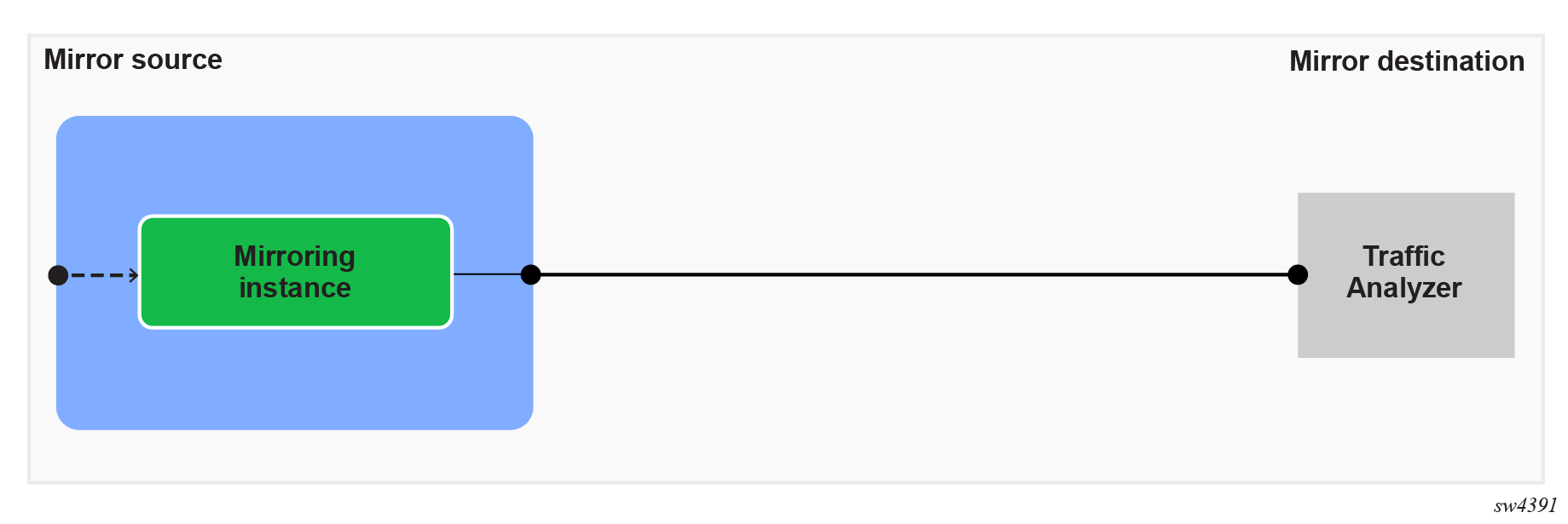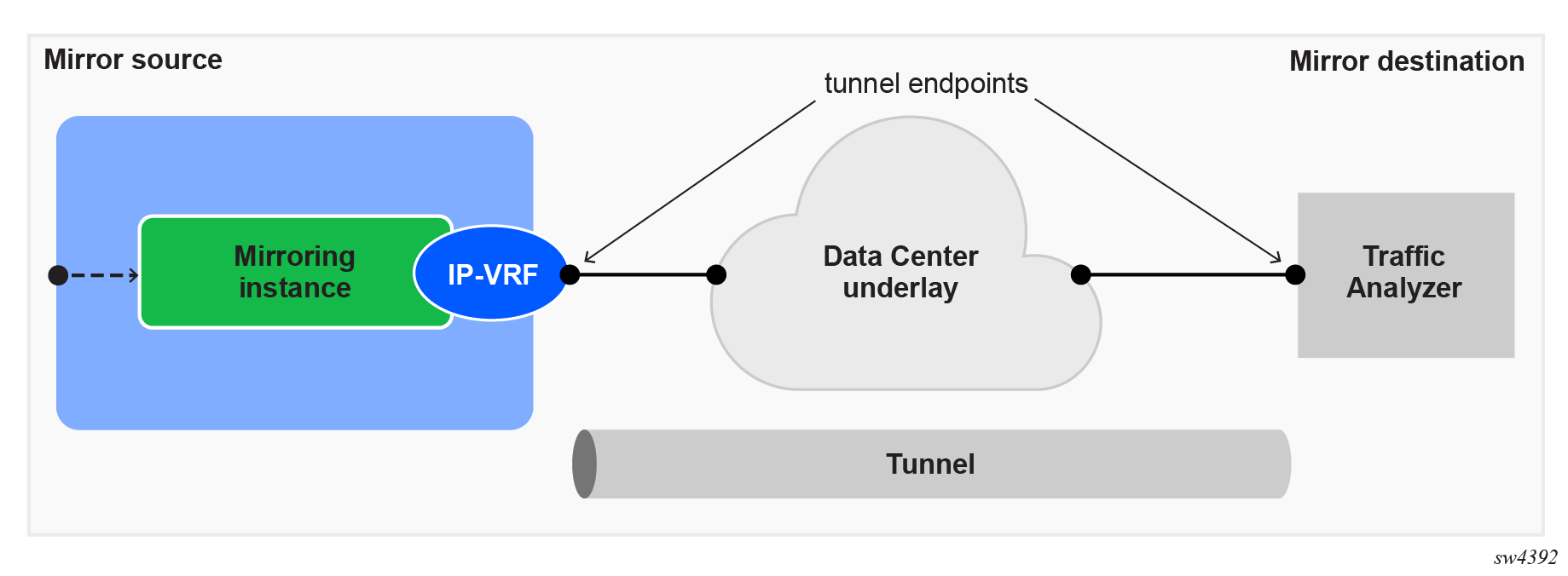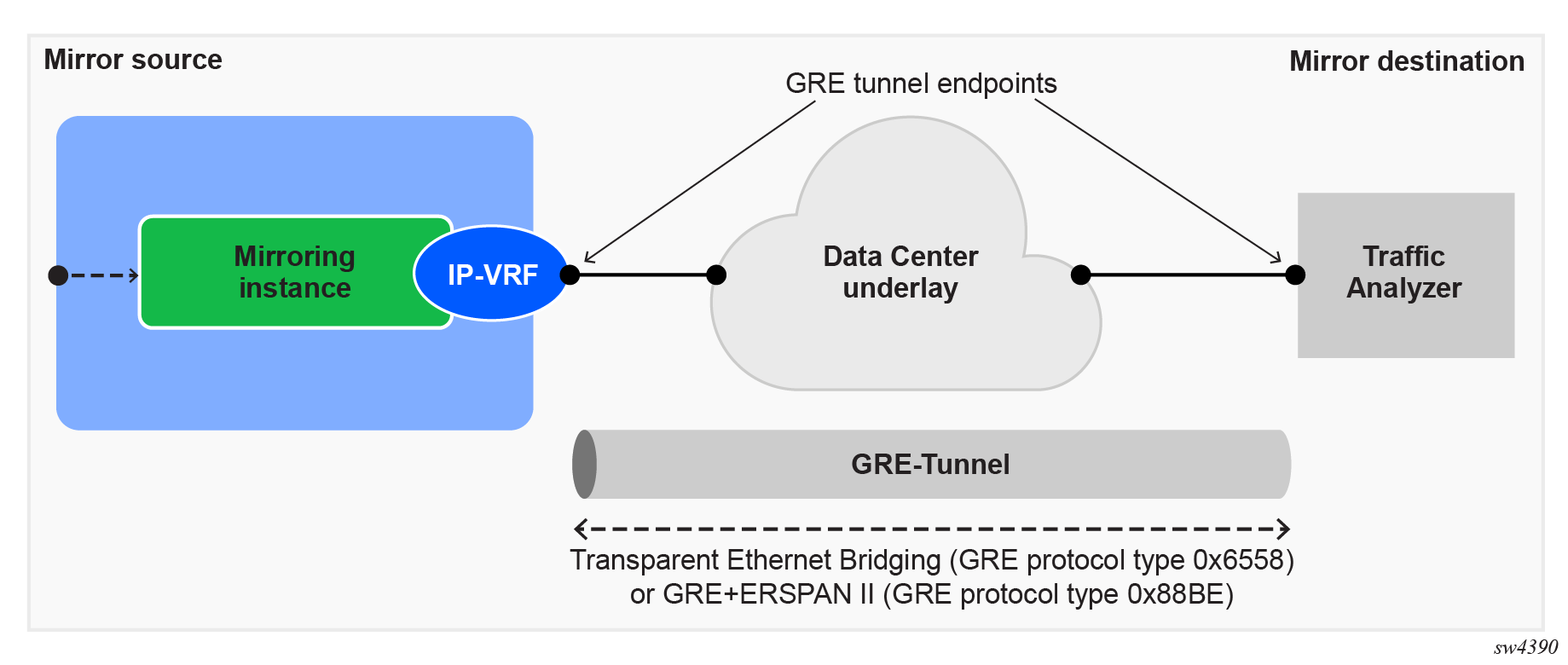Mirroring
Mirroring copies IPv4 and IPv6 packets seen on a specified source, such as an interface (port) or subinterface (VLAN), or matching an ACL entry, and sends the packets to a specific destination, such as a locally attached traffic analyzer or a tunnel toward a remote destination.
By default, the mirrored packets include IPv4/IPv6 headers, as well as Ethernet headers. Traffic from multiple sources can be mirrored to a single destination. Mirroring to multiple destinations is not supported.
Mirror sources
The source for mirrored traffic can be an interface, subinterface, or an ACL filter.
-
Interfaces / subinterfaces
A mirror source can be an interface, including all subinterfaces within that interface. The source can be a single interface (for example,
interface ethernet-1/1) or a LAG (for example,interface lag1). Either a LAG member or LAG port can be mirrored. When a LAG port is configured as a mirror source, mirroring is enabled on all ports making up the LAG.The source can be a specific VLAN; that is, a subinterface within an interface where VLAN tagging is enabled (for example,
interface ethernet-1/1.1orlag1.1).You can configure mirroring for traffic in a specific direction (ingress only, egress only) or bidirectional traffic (both ingress and egress).
The mirror source can stop mirroring packets if system resources are exhausted, causing its operational state to go down. If packets are not mirrored, check the operational state of the mirror sources. This helps identify whether the issue lies with a specific mirror source or the entire mirror instance.
-
ACL filters
A mirror source can be an IPv4 or IPv6 ACL filter, applied under one or more interfaces or subinterfaces. Traffic matching entries in the ingress ACL filter (regardless of whether the action is accept or drop), can be mirrored to the destination.
The following table lists hardware platform support for each mirror source.
| Source | 7220 IXR-D2 7220 IXR-D3 | 7220 IXR-D2L 7220 IXR-D3L | 7220 IXR-D4 7220 IXR-D5 | 7250 IXR-6e 7250 IXR-10e | 7250 IXR-X1b 7250 IXR-X3b | 7730 SXR |
|---|---|---|---|---|---|---|
| Interface (ingress) | Yes | Yes | Yes | Yes | Yes | Yes |
| Interface (egress) | Yes | Yes | Yes | Yes | Yes | Yes |
| Subinterface (ingress) | Yes | Yes | Yes | Yes | Yes | Yes |
| Subinterface (egress) | Yes | Yes | No | Yes | Yes | Yes |
| ACL filter (ingress) | Yes | Yes | Yes | Yes | Yes | No |
| ACL filter (egress) | No | No | No | No | No | No |
-
LAG not supported means that, the packets cannot be mirrored if the source is a LAG.
-
On 7250 IXR systems, the subinterface used as mirror source cannot be of type bridged.
-
On 7250 IXR systems, the LAG member port cannot be mirrored.
Mirror destinations
Traffic from the mirror source can be copied to a local destination (local mirroring) or tunnel to a remote destination (remote mirroring).
Local mirroring
In a local mirroring configuration, both the mirror source and mirror destination reside on the same SR Linux node, as shown in the following figure.
In this configuration, the local destination is a Switched Port Analyzer (SPAN).

For local mirroring, the following hardware types are supported:
-
7220 IXR-D2
-
7220 IXR-D3
-
7220 IXR-D2L
-
7220 IXR-D3L
-
7220 IXR-D4
-
7220 IXR-D5
-
7250 IXR-6e
-
7250 IXR-10e
-
7250 IXR-X1b
-
7250 IXR-X3b
-
7730 SXR
Remote mirroring
In a remote mirroring setup, the mirror source and destination are located on different nodes. As shown in the following figure, the SR Linux node acts as the mirror source, and the mirrored packets are encapsulated into a tunnel toward the mirror destination.
Tunnel endpoints are defined within a specific network-instance, where the local tunnel endpoint IP address can be either a loopback subinterface address or any subinterface address within that network-instance.

The following table summarizes the mirror destination types supported for various platforms. The sections that follow provide more details about each of the remote mirroring tunneling mechanisms.
| Destination | 7220 IXR-D2 7220 IXR-D3 | 7220 IXR-D2L 7220 IXR-D3L | 7220 IXR-D4 7220 IXR-D5 | 7250 IXR-6e 7250 IXR-10e | 7250 IXR-X1b 7250 IXR-X3b | 7730 SXR |
|---|---|---|---|---|---|---|
| Underlay destination (GRE+ERSPAN ll) - IPv4 (ingress and egress | No | No | No | Yes | Yes | No |
| Underlay destination (GRE+ERSPAN ll) - IPv6 (ingress and egress) | No | No | No | Yes | Yes | No |
| Underlay destination (transparent Ethernet bridging) - IPv4 (ingress and egress) | Yes | Yes | Yes | No | No | No |
| Underlay destination (transparent Ethernet bridging) - IPv6 (ingress-direction mirroring) | Yes | Yes | Yes | No | No | No |
| Underlay destination (transparent Ethernet bridging) - IPv6 (egress-direction mirroring) | No | No | Yes | No | No | No |
| IPv4 GRE pseudowire | No | No | No | No | No | Yes |
| MPLS pseudowire | No | No | No | No | No | Yes |
Mirroring utilizing an underlay IP infrastructure
For 7220 IXR-D3, 7220 IXR-D4, and 7220 IXR-D5 devices, the mirrored packets including the Ethernet headers are tunneled to the remote mirror destination with a GRE header using transparent Ethernet bridging (GRE protocol type 0x6558).
For 7250 IXR-6e, 7250 IXR-10e, 7250 IXR-X1b, and 7250 IXR-X3b devices, the mirrored packets including the Ethernet headers are tunneled to the remote mirror destination. The mirrored packet is first encapsulated with an ERSPAN header and then an outer IP-GRE header using Ethernet bridging (GRE protocol type 0x88BE).
The following figure shows a mirroring-to-underlay configuration.

Consider the following when you configure remote mirroring:
-
The system does not place any restrictions on the configuration of the tunnel-end-point destination or source IP address.
-
For an ERSPAN to be functional:
-
the source IP address configured under tunnel-end-point address must be a local interface IP address. This is typically a loopback address on the system
-
there must be a route entry in the routing table destined for the tunnel-end-point destination IP address.
-
Mirroring utilizing a MPLS pseudowire
Most MPLS-capable routers at the remote end can remove the encapsulation and forward the mirrored packet to an analyzer. If you are using IP-GRE, you can also specify an analyzer as the IP destination. In this case, the analyzer receives the full mirrored packet along with the MPLS service label encapsulation.
The 7730 SXR platforms support the following types of transport tunnels for mirroring the traffic:
- GRE
- SR-ISIS
- Colored TE policy
- Uncolored TE policy
The tunnel selection is automatic and based on dynamic resolution. The following operational state parameters display the selected tunnel type:
- operational-tunnel-type: Indicates the resolved tunnel type used for the mirror destination.
- operational-tunnel-id: Identifies the specific tunnel instance in use.
- oper-down-reason: Specifies the reason why the mirror session is in an oper-down state.
Mirror slicing
Slicing is a function that only mirrors a specified packet length of the original packet. This is useful to monitor network usage without having to copy the full packet. Slicing can reduce the mirrored packet to a size that the destination packet decoding equipment can handle. It also allows the conservation of mirroring bandwidth consumption by limiting the size of the stream of packets through the router and the core network.
When a mirror slice-size is defined, it truncates the mirrored frame to the defined size. For example, if the slice size is configured as 256 bytes, only the first 256 bytes of the frame are transmitted to the mirror destination. The original frame is not affected by the truncation. Mirrored frames can be larger then the specified slice size if the mirror destination adds encapsulations for a remote decoder equipment.
The transmission of a sliced or a non-sliced frame is also dependent on the mirror destination path MTU or the mirror destination MTU. Packets with MTU larger than the mirroring destination are discarded.
Configuring mirroring
To configure mirroring, you configure a mirroring-instance, which specifies the source and destination for the mirrored traffic. Multiple mirror sources can have a single destination, although traffic from a specific source cannot be mirrored to multiple destinations. Only one mirror destination can be configured per mirroring-instance. A mirror destination cannot be reused in multiple mirroring instances.
Within a mirroring-instance, if an interface is configured as mirror source, a subinterface within that interface cannot be added as another mirror source. If a LAG is defined as mirror destination, only the first 8 members of the LAG carry mirrored traffic. Note that on 7220 IXR-D4 and 7220 IXR-D5 platforms, a mirror destination port cannot be a LAG.
Mirrored traffic is considered Best Effort (BE) Forwarding Class.
Configuring mirroring sources
To configure mirroring, you specify the source and destination for mirrored traffic within a mirroring-instance. The source in a mirroring-instance can be traffic on a specified interface, subinterface, or LAG, or can be packets matching an ACL entry.
interface source
The following example shows a mirroring-instance configuration with an interface as the source for mirrored traffic:
--{ + candidate shared default }--[ ]--
# info with-context system mirroring
system {
mirroring {
mirroring-instance 1 {
admin-state enable
mirror-source {
interface ethernet-1/5 {
direction ingress-egress
}
}
}
}
}ACL source
The following example configures an ACL with an entry that matches TCP packets and applies the ACL to a subinterface. A mirroring-instance is configured that uses packets matching the ACL as the source for mirrored traffic.
--{ + candidate shared default }--[ ]--
# info with-context acl acl-filter ip_tcp type ipv4
acl {
acl-filter ip_tcp type ipv4 {
entry 1000 {
description Match_TCP_Protocol
match {
ipv4 {
protocol tcp
}
}
action {
accept {
}
}
}
}
}--{ + candidate shared default }--[ ]--
# info with-context acl interface ethernet-1/1.1
acl {
interface ethernet-1/1.1 {
interface-ref {
interface ethernet-1/1
subinterface 1
}
input {
acl-filter ip_tcp type ipv4 {
}
}
}
}--{ + candidate shared default }--[ ]--
# info with-context system mirroring
system {
mirroring {
mirroring-instance 1 {
admin-state enable
mirror-source {
interface ethernet-1/5 {
direction ingress-egress
}
acl {
acl-filter ip_tcp type ipv4 {
entry 1000 {
}
}
}
}
}
}
}Configuring mirroring destinations
In a mirroring-instance, you specify the destination for the mirrored traffic.
The mirroring destination can be a local destination residing on the same SR Linux node as the mirroring source. See Configuring a local mirroring destination for an example of a local mirroring destination configuration.
The mirroring destination can be a remote destination where the mirrored traffic is sent via a tunnel. See Configuring a remote mirroring destination using underlay for an example of a remote mirroring destination configuration.
The 7250 IXR platforms (7250 IXR-6e, 7250 IXR-10e, 7250 IXR-X1b, and 7250 IXR-X3b) support mirroring of packets including the original L2 header. The mirrored packets are then encapsulated with the GRE header and the ERSPAN II header of type 0x88BE.
- if the operational-tunnel-type is GRE, the packet includes a GRE header with Ethernet type 0x8847 followed by the MPLS service label configured in the mirroring context
- if the operation-tunnel-type is sr-te or sr-isis, the Ethernet Type field is also set to 0x8847, indicating an MPLS frame with the service label configured in the mirroring context placed at the bottom of the label stack.
Configuring a local mirroring destination
The following example configures a subinterface to be a local mirror destination.
--{ + candidate shared default }--[ ]--
# info with-context interface ethernet-1/4 subinterface 1
interface ethernet-1/4 {
subinterface 1 {
type local-mirror-dest
admin-state enable
vlan {
encap {
single-tagged {
vlan-id 1127
}
}
}
local-mirror-destination {
admin-state enable
}
}
}Configuring a remote mirroring destination using underlay
The following example configures a mirroring-instance that specifies the mirrored traffic be encapsulated into a tunnel within a network-instance. The mirrored traffic is encapsulated with a GRE header and a ERSPAN header and is tunneled to the remote destination.
For 7250 IXR-6e, 7250 IXR-10e, 7250 IXR-X1b, and 7250 IXR-X3b, the remote encapsulation is L3oGRE. For all other platforms, the encapsulation is L2oGRE.
--{ + candidate shared default }--[ ]--
# info with-context system mirroring
system {
mirroring {
mirroring-instance test {
admin-state enable
mirror-source {
interface ethernet-1/1 {
direction ingress-egress
}
}
mirror-destination {
remote {
encap l2ogre
network-instance IPVRF-1
tunnel-end-points {
source-address 192.168.1.53
destination-address 192.168.1.153
}
}
}
}
}
}Configuring a remote mirroring destination in 7730 SXR platforms
The following example configures a remote mirroring destination in 7730 SXR platforms. In this example, the original packet along with its Layer 2 header is mirrored. The encapsulation used is MPLS over GRE. The tunnel type supported includes IP-GRE, SR-ISIS, and SR-TE).
--{ + candidate shared default }--[ ]--
# info with-context system mirroring mirroring-instance one
system {
mirroring {
mirroring-instance one {
mirror-source {
subinterface lag7.1 {
direction ingress-only
}
}
mirror-destination {
remote {
encap mpls
network-instance green_default
tunnel-end-points {
source-address 1.1.1.1
destination-address 32.1.1.5
admin-state enable
service-label 145
allowed-tunnel-types [
sr-isis
te-policy-sr-mpls-uncolored
]
}
}
}
}
}
}Configuring mirror slice size
To configure a mirror slice size, use the system mirroring mirroring-instance mirror-destination slice-size command.
Configure a mirror slice size
The following example configures a slice size for a mirror destination.
--{ + candidate shared default }--[ ]--
# info with-context system mirroring mirroring-instance test
system {
mirroring {
mirroring-instance test {
admin-state enable
mirror-source {
interface ethernet-1/1 {
direction ingress-egress
}
}
mirror-destination {
slice-size 256
remote {
encap mpls
network-instance IPVRF-1
tunnel-end-points {
source-address 192.168.1.53
destination-address 192.168.1.153
service-label 16
allowed-tunnel-types [
gre
]
}
}
}
}
}
}Displaying mirroring information
Use the info from state command to display mirroring configuration information.
Displaying mirroring configuration information in 7250 IXR devices
--{ * candidate shared default }--[ ]--
# info from state with-context system mirroring mirroring-instance 2
system {
mirroring {
mirroring-instance 2 {
admin-state enable
oper-state down
oper-down-reason local-mirror-subif-down
mirror-source {
interface lag1 {
direction ingress-egress
}
}
mirror-destination {
local lag25.1
}
}
}
}
Displaying mirroring configuration information in 7730 SXR devices
--{ + candidate shared default }--[ ]--
# info from state with-context system mirroring
mirroring-instance m1 {
admin-state enable
oper-state up
mirror-source {
interface ethernet-1/11 {
direction ingress-only
}
}
mirror-destination {
slice-size 0
remote {
encap mpls
network-instance base
tunnel-end-points {
source-address 1.1.1.2
destination-address 1.1.1.3
admin-state enable
service-label 234
oper-state up
operational-tunnel-type sr-isis
operational-tunnel-id 23000
allowed-tunnel-types [
sr-isis
te-policy-sr-mpls-colored
]
}
}
}
}Displaying mirroring statistics
On 7220 IXR-D2, 7220 IXR-D3, and 7730 SXR platforms, you can display the statistics per mirror destination interface using the info from state interface statistics command. Filter out-mirrored-packets and the out-mirror-octets fields. See Mirroring statistics on 7220 IXR-D2, 7220 IXR-D3, and 7730 SXR platforms for an example of displaying 7220 IXR-D2, 7220 IXR-D3, and 7730 SXR mirroring statistics.
On 7220 IXR-D4, 7220 IXR-D5, 7250 IXR-6e, 7250 IXR-10e, 7250 IXR-X1b. and 7250 IXR-X3b platforms, mirror destination statistics are not supported per-interface; it is only possible to display per-mirror-destination statistics. The statistics show the number of packets sent to the mirror destination. See Mirroring statistics on 7250 IXR-6e, 7250 IXR-10e platforms for an example of displaying 7250 IXR-6e, 7250 IXR-10e mirroring statistics.
On 7220 IXR-D4 and 7220 IXR-D5 platforms, the statistics only include the number of packets mirrored in either the ingress or the egress direction. On 7250 IXR-6e, 7250 IXR-10e, and 7250 IXR-X3b platforms, the statistics include the number of packets in the ingress direction and the number of octets mirrored in either the ingress or the egress direction.
See Mirroring statistics on 7220 IXR-D5 platform for an example of displaying 7220 IXR-D5 mirroring statistics.The octet count for ERSPAN includes the GRE header (not just the actual mirror packet). The interfaces that egress the mirrored packet must adjust the MTU size to accommodate that additional GRE header. If the MTU size is smaller than the GRE packet, the mirrored packet is dropped.
There are no packet drop statistics for mirror destinations. The statistics represent all packets that have been successfully mirrored and sent to the mirror destination. It is possible for mirrored packets to be dropped because of over-congestion of multiple mirror sources to the same mirror destination. Mirrored packet drops can also occur because a mirror destination interface can be used for regular data traffic forwarding.
Mirroring statistics on 7220 IXR-D2, 7220 IXR-D3, and 7730 SXR platforms
--{ running }--[ ]--
# info from state with-context interface ethernet-1/48 statistics | filter fields out-mirror-octets out-mirror-packets
interface ethernet-1/48 {
statistics {
out-mirror-octets 0
out-mirror-packets 0
}
Mirroring statistics on 7250 IXR-6e, 7250 IXR-10e platforms
--{ running }--[ ]--
# info from state with-context system mirroring mirroring-instance ixia_one mirror-destination statistics
system {
mirroring {
mirroring-instance ixia_one {
mirror-destination {
statistics {
ingress-mirrored-packets 7417657
ingress-mirrored-octets 10384702600
egress-mirrored-octets 0
}
}
}
}
}
Mirroring statistics on 7220 IXR-D5 platform
--{ running }--[ ]--
# info from state with-context system mirroring mirroring-instance * mirror-destination statistics
system {
mirroring {
mirroring-instance eight {
mirror-destination {
statistics {
ingress-mirrored-packets 22135
egress-mirrored-packets 22132
}
}
}
mirroring-instance five {
mirror-destination {
statistics {
ingress-mirrored-packets 6353567
egress-mirrored-packets 0
}
}
}
}
}